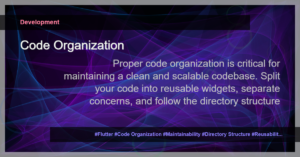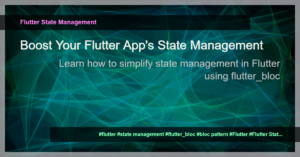Introduction
Are you preparing for a Flutter interview? Congratulations! Flutter is a popular framework for building cross-platform mobile applications, and being well-prepared for your interview can give you a significant advantage.
However, it’s essential to have a solid understanding of common Flutter interview questions and be able to provide insightful answers. In this article, we will discuss ten common Flutter interview questions and provide detailed explanations to help you prepare.
1. What is Flutter?
Flutter is an open-source UI software development kit created by Google. It allows developers to build high-quality native interfaces for iOS and Android using a single codebase. Flutter uses the Dart programming language and provides a rich set of customizable widgets.
import 'package:flutter/material.dart';
void main() {
runApp(MyApp());
}
class MyApp extends StatelessWidget {
@override
Widget build(BuildContext context) {
return MaterialApp(
title: 'Flutter App',
theme: ThemeData(
primarySwatch: Colors.blue,
),
home: Scaffold(
appBar: AppBar(
title: Text('Flutter App'),
),
body: Center(
child: Text('Hello, Flutter!'),
),
),
);
}
}
2. What are the advantages of Flutter?
- Hot Reload: Flutter’s hot reload feature allows developers to see the changes they make in real-time, speeding up the development process.
- Single Codebase: Flutter enables developers to write a single codebase for both iOS and Android, reducing development time and effort.
- Beautiful UI: Flutter provides a wide range of customizable widgets and allows developers to create stunning, pixel-perfect user interfaces.
- Performance: Flutter apps deliver high performance as the UI is rendered through its own widgets, resulting in smooth animations and transitions.
- Fast Development: Flutter’s rich set of pre-built widgets and the availability of third-party packages make app development faster and more efficient.
3. What is the difference between StatelessWidget and StatefulWidget?
StatelessWidget is a widget that does not depend on any mutable state. It remains the same throughout its lifetime and is ideal for static content. On the other hand, StatefulWidget is a widget that can change its appearance based on mutable state. It is used for interactive UI elements that need to update based on user actions or data changes.
4. Explain the concept of Widget in Flutter.
In Flutter, everything is a widget. Widgets are UI elements that can be composed together to create the user interface of an app. There are two types of widgets: StatelessWidget and StatefulWidget. StatelessWidget represents immutable UI elements, while StatefulWidget represents UI elements that can change based on mutable state.
5. What is the pubspec.yaml file in Flutter?
The pubspec.yaml file is a YAML configuration file used in Flutter projects. It defines the project’s metadata, including the project name, dependencies, assets, and more. Developers use this file to manage dependencies, specify assets like images and fonts, and configure other project settings.
6. How does Hot Reload work in Flutter?
Hot Reload is a feature in Flutter that allows developers to make changes to their code and see the results instantly, without restarting the app. When a developer saves their changes, Flutter recompiles only the modified code and applies the updates to the running app, preserving the app’s state.
7. Explain the concept of State Management in Flutter.
State Management is the process of managing the state of an application. In Flutter, there are various state management techniques available, such as Provider, BLoC (Business Logic Component), Redux, and GetX. These techniques help developers handle the flow of data and maintain the state of UI elements efficiently.
8. What is the difference between StatelessWidget and StatefulWidget?
StatelessWidget is a widget that does not depend on any mutable state. It remains the same throughout its lifetime and is ideal for static content. On the other hand, StatefulWidget is a widget that can change its appearance based on mutable state. It is used for interactive UI elements that need to update based on user actions or data changes.
9. Explain the concept of Widget in Flutter.
In Flutter, everything is a widget. Widgets are UI elements that can be composed together to create the user interface of an app. There are two types of widgets: StatelessWidget and StatefulWidget. StatelessWidget represents immutable UI elements, while StatefulWidget represents UI elements that can change based on mutable state.
10. What is the pubspec.yaml file in Flutter?
The pubspec.yaml file is a YAML configuration file used in Flutter projects. It defines the project’s metadata, including the project name, dependencies, assets, and more. Developers use this file to manage dependencies, specify assets like images and fonts, and configure other project settings.
Conclusion
By familiarizing yourself with these common Flutter interview questions and their answers, you can boost your confidence and be well-prepared for your next interview. Remember to practice writing code examples whenever possible and showcase your problem-solving skills. Good luck with your Flutter interview!







